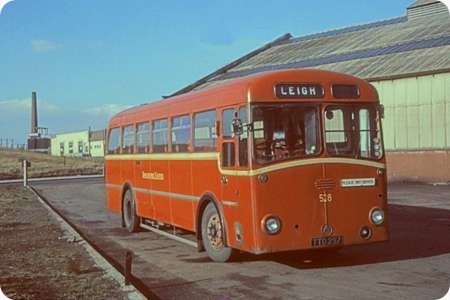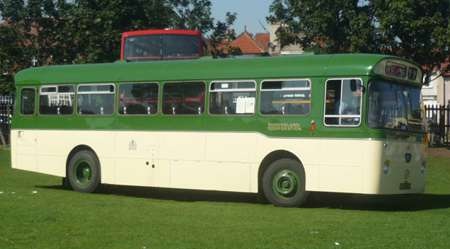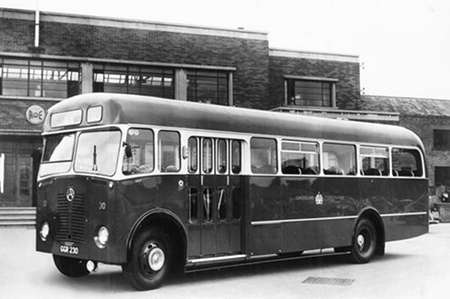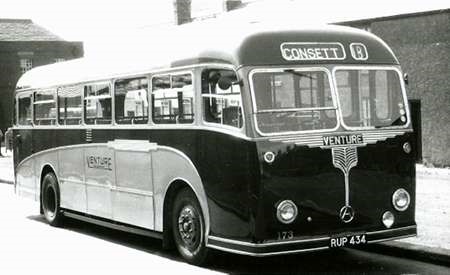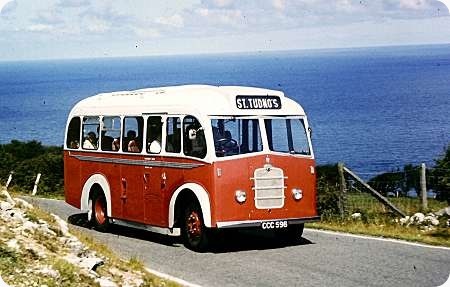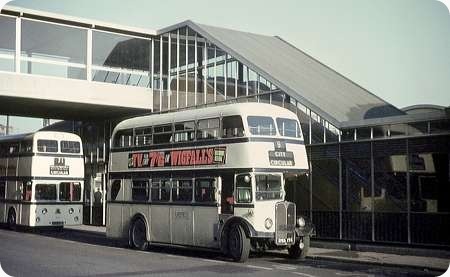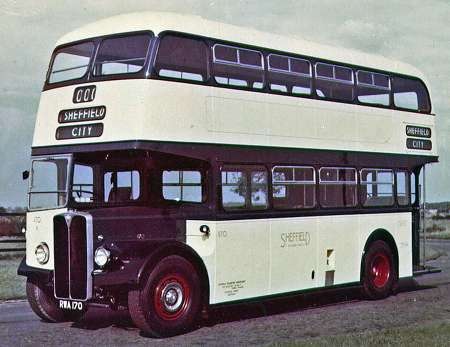Lancashire United Transport – Atkinson Alpha – TTD 297 – 528
Lancashire United Transport
1954
Atkinson Alpha PL745H
Roe B44F
When the BET subsidiary and previously staunch Bristol user North Western Road Car Co. found itself unable to continue buying its favourite make of chassis (due to the manufacturer falling under state-owned BTC ownership and only able to supply to other similarly owned companies), NWRCC management, not to be outdone, sought the services of the independent truck maker Atkinson Lorries (1933) Ltd. of Walton-le-Dale to produce an equivalent to the underfloor-engined Bristol LS model which they would no doubt have otherwise purchased.
The new model was christened the Alpha, and the first ones were duly delivered to NWRCC in 1951. However the BET Group were having none of it and stepped in to force its companies to stick to its preferred choice of Leyland Tiger Cub or AEC Reliance.
Atkinson continued with the Alpha though, which was initially offered as a mediumweight model, fitted with a choice of Gardner 4, 5 or 6HLW engines, and either an Atkinson 5-speed overdrive constant-mesh or David Brown 5-speed direct top synchromesh gearbox. At the 1953 Scottish Show they displayed an Alpha fitted with Self-Changing Gears semi-automatic gearbox – quoted as being the first to be fitted to a PSV chassis (Leyland – owner of SCG – had a minority shareholding in Atkinson at the time). At the same time a lightweight version was offered. Apart from orders for 40 for LUT, and 20 for Venture of Consett, the rest were mostly supplied as coaches in small or single numbers. Production diminished throughout the 1950’s, the model’s swansong occurring in 1963 when Sunderland Corporation surprised everyone by taking three updated 33ft. long buses with semi-automatic gearboxes and modern-style Marshall bodies, but these were the last of the line.
LUT took a batch of ten in each year from 1952 to 1955, and 528 (TTD 297) seen here at their Atherton Depot was a model PL745H with Roe B44F body, new in 1954.
Photograph and Copy contributed by John Stringer
24/04/14 – 08:21
Weren’t the first NWRCC examples delivered with single rear wheels, but the road holding, or lack of it, lead to the more normal twin rear wheels being subsequently fitted?
Did any other operator take single wheel Alphas?
Eric Bawden
24/04/14 – 08:22
If my memory isn’t faulty (and it often is these days) I have a feeling that Sunderland Corp’n took delivery of some earlier Alphas, with similar Roe bodies, in the mid-1950’s.
Chris Hebbron
24/04/14 – 08:22
A survivor from the three Atkinsons bought by Sunderland Corporation. I took the photo at the 2013 N.E.B.P.T rally at Seaburn, which is to the north of Sunderland, so no doubt the bus would have been used on services in the area at some time during its working life.
Ronnie Hoye
24/04/14 – 11:37
Sorry folks, in my haste I forgot to add the fleet and registration numbers for the Sunderland Atkinson. WBR 248 fleet number 48. More photos of the vehicle were posted in my Metro Center May 2013 gallery.
Ronnie Hoye
24/04/14 – 11:38
The NWRCC Alphas did have single rear wheels, something the company tinkered with on and off in the 1950s.
Phil Blinkhorn
24/04/14 – 11:39
Here’s an official photo of one of the earlier Alphas, with Roe bodies, which Sunderland Corp’n bought and I mentioned earlier.
Chris Hebbron
24/04/14 – 15:47
So upset was the North Western manager by the BET reaction he resigned and left the company.
Chris Hough
24/04/14 – 15:47
Just one minor point, John. Self Changing Gears did not succumb to Leyland control until 1957, when the Lancashire maker bought the Hawker Siddeley third of the shares in the company. Prior to that, the Wilson family, Hawker Siddeley and Leyland each owned a third. The Atkinson shown in Chris Hebbron’s picture was earlier one of two L644LWEXL long wheelbase models with front mounted vertical 4LW engines bought by Sunderland in 1956/7. The Leyland shareholding in the Atkinson company proved to be the decisive factor in the tragic sale of Atkinson to Seddon in 1970. Leyland decided to take the Oldham money and run.
Roger Cox
25/04/14 – 07:29
It is surprising that a large proportion of the Atkinson buses had unusual bodies. All the North Western Alphas had rear entrance bodies, and many of the Lancashire United examples had centre-entrance standee bodies, as did four of those for SHMD Board. The last three for SHMD had front entrance standee bodies, and the one-off double decker had centre entrance. Even the front entrance Roe bodied Alphas for LUT had an unusual (but attractive) appearance, and the driver had an offside cab door.
Surely the two Sunderland Atkinsons bought in the fifties were not Alphas, but modified lorry chassis.
Just think, if the BET Group management had not been so awkward, North Western might have bought a couple of hundred Atkinson Alphas instead of Royal Tigers, Tiger Cubs and Reliances of the FDB, KDB and LDB series.
Don McKeown
25/04/14 – 07:30
Strange isn’t it. You would expect Atkinsons with their quality and traditional reputation and low volumes to be an ideal manufacturer for the bus industry. No, it has to be Leyland or AEC. Eventually, they all eat each other, aided by too much direction- are rear engines or double deckers the answer to everything- so we now have over-large, wallowing buses with all the control subtlety of a dodgem. Am I being unfair?!
Joe
25/04/14 – 11:47
I tend to agree with Don’s comment about the lorry chassis. The layout is probably the most odd of all the Atkinson bus production as, to an extent, all the other body layouts followed traditional or, at least, accepted formats yet a long wheelbase with a double width door behind the front axle needs some explanation!
Phil Blinkhorn
25/04/14 – 14:24
The Atkinson L644 was a lorry chassis – L=Long wheelbase, 6=6 tonner, 4=4-wheel, 4=4cyl. The suffix LWEXL presumably means LW=Gardner LW (though this was not usually used on lorries, being taken for granted), EXL=Extra Long (being longer than the standard lwb lorry).
I’ve only ever seen these on photographs, but always thought they looked rather good, and that Roe had made a very neat job of them. The double width door looks unusual on a front-engined single decker, and the grille looks like a throwback to the BMMO S6 or D5. It’s almost like a slightly longer and more substantial alternative to the Bristol SC. I’m told however that their appeal stopped with their appearance, and that they were rather unrefined in reality.
John Stringer
27/04/14 – 08:08
Although it was based upon a lorry chassis, one presumes that the frames of the Sunderland buses were dropped in the conventional psv fashion to permit a reasonable floor height. I entirely agree that the 4LW engine would have been a far from refined power unit, even with a flexible mounting. (Nonetheless, the prewar Dennis Lancet with four cylinder petrol or diesel power was noted for smooth running.) The 4LW had a capacity of 5.6 litres, almost exactly the same as the experimental 6LK engine made in the 1930s but not produced in volume. No doubt the 6LK would have been more costly to produce than the 4LW, but it would have given Gardner an effective, reliable, refined 5.7 litre 85 bhp high speed six cylinder engine, suitable for automotive applications where the 4LW was much too ponderous. An excellent opportunity was lost. Under Hugh Gardner’s autocratic management style the company’s production methods did not evolve with the passage of time, and were essentially very inefficient by the 1960s, a factor that was reflected in the level of output and the unit cost. During the 1968 strike in the foundry section, personnel from other parts of the Patricroft works stepped in to maintain production. It was discovered that the technique used for the sand core for one complex casting could be simplified, reducing the manufacturing time from 40 minutes to 12 seconds. No doubt similar economies could have been effected in other processes had the will been there to take a proper look. After the 1973 strike, during which some 600 skilled employees left the Patricroft firm for employment elsewhere, the continued demand for the LX series engines had to be met by ending production of the 4LK and 4/5/6LW ranges for which markets still existed. When, in the following year, Rolls Royce decided to pull out of making diesel engines, Paul Gardner suggested that the Patricroft firm should buy the Shrewsbury factory, equipped as it was with modern manufacturing plant. Hugh Gardner responded by threatening to resign, and the project was dropped. Paul was told to apologise for wasting the board’s time. What might have been!
Roger Cox
27/04/14 – 12:58
Thx for the insight into Gardner’s problem boss. So many livelihoods affected, often those of talented people by such high-handed and misguided behaviour.
Can you say, Roger, why the Gardner strikes occurred and why R-R pulled out of road vehicle engine manufacture?
Chris Hebbron
27/04/14 – 16:16
Chris, the comprehensive record of Gardner history is the 2002 book by Graham Edge. In August 1968, a certain shop steward in the iron foundry shop took it upon himself, presumably arising from some grievance, to cast the name ‘Gardner’ upside down on the crankcase of the large and expensive 8L3B engine. He was repeatedly warned to no effect and was ultimately suspended. The other stewards in the foundry then called a strike that lasted until September, when the action collapsed and the staff returned to work, having lost their centenary bonus. The initial troublemaker left the plant soon afterwards. The 1973 dispute was more serious, and fell within a pattern of strikes that plagued almost all the UK motor manufacturing industries of the time. By the end of 1973, when settlement was made, production of engines at Patricroft had fallen to a level, 2937 units, that was half that of the two previous years. This strike was instrumental in the move by those manufacturers traditionally employing Gardner engines towards fitting other makes of motive power. Hugh Gardner was an autocrat and must surely have been an unreceptive individual at every negotiating table with the trades unions. It is possible that an undercurrent of labour dispute arose from personal resentment by the union representatives, but the eventual outcome was yet another tragedy for British industry. The appointment of Clayton Flint as Chairman in 1975, the first ‘non Family’ person ever to hold the post, led to more flexible management of the company and improved production efficiency, particularly in the foundry shop. The rigid resistance to change ceased to be, and Paul Gardner, at last, was permitted to take Gardner engines into the world of turbocharging. Sadly, it was all too late, and even the sale of the business to Hawker Siddeley could not save Gardner. New engines were rushed into production too soon, and reliability, hitherto synonymous with the name Gardner, began to fall short. In the recession of the 1980s, during which the smaller independent commercial vehicle makers began to fall by the wayside, Hawker Siddeley lost interest in Gardner and sold off the company to Perkins. The writing was finally on the wall. Perkins disposed of Gardner by 1994, and automotive engine production ceased soon afterwards, followed by marine production three years later. The residual engine parts and support business became Gardner Avon, but this is now a non trading company. Today, the so called Gardner group is a supplier to the aerospace industry. It has several sites in the UK, but Manchester is not one of them.
Roger Cox
28/04/14 – 08:27
The North Western manager who resigned when BET refused to approve the purchase of further Atkinsons was Mr H S Driver, the company’s chief engineer. He had appealed to try to have this decision overturned, but without success. He later became Gardner technical representative for Australasia, and did not return to the UK.
David Williamson
28/04/14 – 08:27
Thanks, Roger, for that detailed, illuminating and depressing story, much of it so common in those days. That was when much of the Great went out of Great Britain!
Chris Hebbron
29/04/14 – 07:55
I’d been wondering what had happened to Gardner: there they were supplying engines, along came "uniformed service" and I sort of dropped out of bus-related business . . . then when I picked-up my interest again it was in a world without Gardner.
I do remember reading somewhere that there was a specific reason why Sunderland ordered those long-wheelbase forward-entrance Atkinsons to that forma- but I can’t remember now what I read or where I read it. Something about a heavily-trafficked night/works service seems to ring a bell.
Philip Rushworth
29/04/14 – 07:55
Much of the BET Group’s vehicle policy was determined by the availability of bulk discounts. Atkinson would probably have been unable to provide the bulk, never mind the discount. NWRC’s Mr Driver had allegedly been responsible for the creation of the Alpha, and had certainly worked closely with the manufacturer to get the spec just so for the operator. But when he went to BET HQ to plead his case, he was told that Royal Tigers had already been allocated to NWRC from a Leyland bulk order, and that was that. (Info from Glory Days: North Western by A E Jones.)
Peter Williamson
30/04/14 – 07:26
Very grateful to Roger for the detailed account of Gardner’s sad slide into nothingness. Having no understanding of the business side of things, I went through life blissfully confident that Gardner’s products always had been, were and always would be the finest available on earth. Of course that was once true, but I had my illusion shattered one day at Dover, where a driver had open the back panel of his bus. (I can’t remember the make of vehicle, and was the engine a 6LXCT or did it have a slightly bigger bore?) I expected him to share my enthusiasm, but his tales were of woe, and I went away with a painfully updated understanding, although I still had no idea how long the problems had been festering.
Also fascinated to read that a 6LK had actually been built. A friend used to fantasize about such an engine. It could have competed directly with the Perkins 6.354—though certainly not on price!
Ian Thompson
01/05/14 – 08:24
Thanks Roger for your detailed account of the sad demise of Gardner. I always had (and still have) the utmost respect for their products, which were built to a very high standard as is well documented, and were often known as ‘the crème de la crème of diesel engines’. (Indeed, when the 6LXB was announced, it was regarded as the world’s most fuel-efficient diesel engine at 40% efficiency). It is also well known that Hugh Gardner was most dogmatic in his views on engine design and how the company was to be run, which no doubt maintained standards, but in the longer term stifled Gardner’s ability to move with the times. As Roger says, Paul Gardner eventually started to take the company forward but it was somehow too late. Certainly the new Gardner LYT engine fell short regarding reliability, and stories of broken crankshafts began to circulate. This was something unheard of with the LW/LX/LXB engines (unless serious maltreatment had occurred), despite their crankshafts not being of fully-hardened construction. The 6LXB continued to have a strong following in the bus market, and the ’30 tons and under’ truck market well into the ‘eighties. Then along came bus deregulation and privatisation, causing widespread disruption to full-sized vehicle manufacturers’ orders following an unpredicted swing to minibuses by operators. There was also, if memory serves correctly, a recession in the construction industry, and haulage companies were also being squeezed by competition from European hauliers. The likes of Volvo, Scania and DAF were also making inroads into the truck market, with more comfortable cabs and higher output engines. Such manufacturers built their own engines which did not help Gardner’s plight. It really is sad how the mighty have fallen. Forty years ago who would have predicted that Gardner, Leyland, Foden, ERF and Seddon-Atkinson would no longer exist in the early 21st century?
Brendan Smith
01/05/14 – 08:25
Many Gardner engines had an afterlife, they were snapped up by showmen who converted them for use as fairground generators. Ironically, since the regulations for silent running generators came into force, many of those that didn’t end up going abroad have been sold to preservation groups, some for spares, but I know of one that will go into a bus which was bought minus and engine, and is currently being restored.
Ronnie Hoye
01/05/14 – 08:25
Ian, following the apocalypse of deregulation, and the acquisition of the "split up" NBC companies by profiteers, I found myself, after five years in non psv work, working at Viscount, Peterborough, the western division of the Cambus outfit. One of the Olympians there was equipped with a 6LXCT engine for the Northampton service, which was operated jointly with Stagecoach United Counties. When outshopped from overhaul, it was often allocated to other services. If it was fully on song, this bus could really motor – I once reached an indicated 70 mph with it when endeavouring to recover lost time on the A1 route to Huntingdon – but the turbocharger arrangement was sadly lacking in durability, and regularly failed. The brakes on this bus were truly dreadful, well up to the tradition of PD3s of the past, and this also tempered one’s inclination to indulge in maximum power. In trying to catch up with other manufacturers in the brave new world of turbocharging, the later Gardner efforts were under developed and under capitalised. The eyes of the top brass at Hawker Siddeley moved instinctively to the net result figure at the bottom of the P/L sheet. The past industrial environment of steady development testing had irretrievably gone, and, after nine years of ownership, Hawker Siddeley lost interest. The sale of Gardner to Perkins in May 1986 was the final kiss of death. Perkins had already taken over the Rolls Royce diesel range, and serious investment in Gardner development was deemed commercially unrewarding. The introduction of the Euro emission regulations was the final blow. Perkins disposed of Gardner in August 1992, by which time most of the output consisted of engine remanufacturing/reconditioning. Perkins/RR and Cummins then ruled the roads and the waves, but they, too, were soon to be seriously threatened by the continental onslaught.
Roger Cox
01/05/14 – 11:48
Scania and DAF both based their success on developing the Leyland O.600/O.680, which they both originally built under licence. There is also uncorroborated evidence that there was a similar beginning to the Volvo story. Another case of the Thatcherite selling off of the family silver.
David Oldfield
01/05/14 – 11:49
….and who, Brendan, would ever have foretold that the lone survivor of all the British mid/heavy transport manufacturers would be Dennis, albeit mainly in the bus field! Perkins is still around, but not in the transport field. Such proud names consigned to history.
How lucky we were to have been around to experience and enjoy their products. Oh dear, I’m at risk of becoming maudlin!
Chris Hebbron
01/05/14 – 18:16
David, if you listen to a Scania you can hear the Lancashire accent!
Phil Blinkhorn
02/05/14 – 07:35
You’re right Chris, who indeed would have thought Dennis would rise to such a prominent position in the bus world bless ’em? And where did Wright’s spring from all of a sudden? Nice one Phil. I’ll listen more closely to Yorkshire Tiger’s Omnicity on the Bradford service next time I’m in Harrogate bus station.
Brendan Smith
02/05/14 – 07:36
I first noticed the Lancashire accent driving a new Scania K113 in 1995, Phil. [Especially driving up the hill toward the Air Balloon – leaving Gloucester in the Cirencester direction.]
David Oldfield
02/05/14 – 10:19
The accent is most noticeable on tickover. I can well understand how driving up towards the Air Balloon would bring out the Leyland in a Scania.
Phil Blinkhorn
02/05/14 – 10:20
Brendan. Wrights were around for years building school buses, welfare vehicles and libraries for appropriate "boards" in Northern Ireland. Their joint venture with GM to produce an advanced coach probably first brought them to attention here but it was almost certainly the Handibus – on the Dart – which set things flying. The use of Alusuisse and quality work didn’t harm them, either.
David Oldfield
02/05/14 – 15:17
Thanks for the info David. I am aware of the Handibus/Dart connection, but I had not realised that their history went quite so far back with vehicles produced for what we would probably term ‘Local Authority’ departments. They appeared to really take off following the arrival of the attractively styled Cadet/Renown-type single-deck bodies. The Wright-bodied vehicles for Blazefield certainly seem well put together and have stood the test of time in the various fleets. In some respects it could be argued that long term, Wright’s have taken up the slack left by the closure of ECW. I must admit however that I much preferred the styling of the latter.
Brendan Smith
06/09/14 – 06:30
Regarding the North Western Atkinson Alphas being rear entrance I understood this was because many queue barriers etc were designed, at that time, for rear entrances (which had been standard until then). For example an allocation of Alphas were needed at Urmston to service the 22 (Levenshulme-Eccles) which was joint with Manchester Corporation, who used rear entrance Royal Tigers, as the very substantial barriers at Eccles Bus Station, Davyhulme Nags Head etc. were positioned to suit rear entrances.
Richard Ward
24/04/15 – 06:22
May I ask through this column, for more information (or where to find information) about the BET Preferred Suppliers list. I find this aspect of PSV history quite disturbing, that private companies could be dictated to in this way. One wonders how many BET group managers would have preferred to take Gardner engined products, and how different PSV history would have been given a level playing field.
Allan White
24/04/15 – 13:34
Allan, I’m not sure of your premise. BET owned each individual company. As owner it could dictate policy to its constituents which, though each had its own General Manager, was really a branch of the main company with a small degree of autonomy. The individual operating companies were not private companies and, as BET was a FTSE listed company, their results contributed to the group balance sheet and affected the share price.
Nothing unusual in that in just about every sector of business.
The classic case of North Western and Atkinson may be the case in point which has sparked your comment. BET had decided that the group would buy Leyland Royal Tigers and later, Tiger Cubs. The deal was financially beneficial to the group as a whole. The fact that NWRCC had its own preference that was overruled may well have been a bad operational decision where financial gain perhaps overcame common sense but in my long experience of working for and with companies within groups, in a number of industries, this is by no means unusual.
Phil Blinkhorn
25/04/15 – 07:05
The Aldershot & District Traction Company was owned in equal third parts by the BET, the THC (ex Southern Railway shareholding) and private shareholders, and this gave it some latitude in its vehicle choices, predominantly Dennis until the influx of the all conquering AEC Reliance. I don’t know if any other BET group companies still had an element of private shareholding up to the 1968 sell out to the government. The ‘delisting’ of certain suppliers, fundamentally in favour of AEC and Leyland, was prompted purely by the economies achievable through bulk ordering. Whether or not BET got the best vehicles through this arrangement is arguable. For example, some BET companies, notably the Northern General group, East Kent and, to a lesser extent, Southdown amongst others, were well satisfied with the Guy Arab, probably the most reliable and economic bus of its time, and they must have been less than pleased when further purchases were vetoed from ‘above’. Even so, individual companies still had some input into the specification of their orders. The Southdown full fronted PD3s, often called ‘Queen Marys’, were unlike anything else in the BET group, apart from the roughly similar Ribble machines. I am sure that other contributors can give similar examples.
Roger Cox
ps I should have added the East Kent full fronted Regent V ‘Puffins’ to the list of distinctive individual orders.
28/11/15 – 06:01
Harking back to Gardner for a moment, were any engines ever fitted to diesel trains, British or foreign? I’m only ever aware of mainly AEC ones and, later, Cummins and possibly the odd Leyland, but it seems to me that the ever-reliable Gardner, which, on the surface, would have seemed the ideal choice, never penetrated the rail market. Or am I wrong?
Chris Hebbron
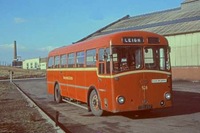 Vehicle reminder shot for this posting
Vehicle reminder shot for this posting
30/12/20 – 10:47
Atkinson Alpha BPL745H with Willowbrook B45F built in 1955 for The Venture Transport Company. They must have proved able workhorses as Venture bought twenty four over a period of two years. The operating area was mostly west Durham and consisted of difficult hilly terrain south of Newcastle and the Tyne valley.
Part of the second batch of six purchased was RUP 434 fleet No.173, the others being RUP 433/8 and numbered 172 – 177. The 1956/7 versions received a more simplified livery and less maroon to the front and sides and straight cab side windows. Photo from my collection, photographer unknown.
Ray Jackson
Quick links to the - Comments Page - Contact Page - Home Page
